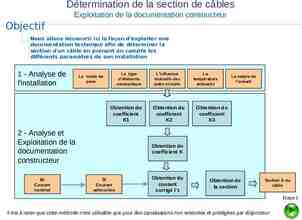Physics 320: Telescopes and Detectors (Lecture 5) Dale Gary NJIT
17 Slides1.50 MB

Physics 320: Telescopes and Detectors (Lecture 5) Dale Gary NJIT Physics Department

Optical Telescope Types Optical telescopes use either a lens or mirror to collect and focus light. There are two basic types, depending on whether the main element, or objective, is a lens (refracting telescope) or a mirror (reflecting telescope), but there are many subtypes. from Sky & Telescope Although telescopes magnify what they see, the main purpose is not magnification, but collecting light. September 18, 2018

Optics and Ray Tracing Simple ray tracing techniques exist for determining for a given optic (either a lens or a mirror) where an image forms, given an image distance. The method is illustrated in the diagrams below. parallel ray cent e p r ray f parallel ray q Geometric optics ray tracing for a thin lens. Given the focal distance f, and the object distance p, one can determine the distance to the image q, geometrically. The rules are simple: parallel rays go through the focus, and rays through the center of the lens do not bend. parallel ray Geometric optics ray tracing for a mirror works the same way. The rules are: parallel rays go through the focus, and rays that hit the center of the mirror bounce off symmetrically. f e cent r ray q parallel ray 1 1 The relationship is given by the formula: 1 𝑓 𝑝 𝑞 p September 18, 2018

Len-Maker’s Formula Another important formula is the lens-maker's formula: 1 1 1 (𝑛𝜆 1 ) 𝑓𝜆 𝑅 1 𝑅2 ( where nl is the index of refraction at wavelength l, and R1 and R2 are the radii of curvature of the lens (negative radius for a diverging lens). Note that this formula assumes the lens is in a vacuum (works approximately for air). If the lens is in a medium with index of refraction full is 1 n0(,𝑛the 𝜆 𝑛 0 ) equation 1 1 𝑓𝜆 ) 𝑛0 (𝑅 𝑅 ) 1 2 Note that the index of refraction depends on wavelength (see http://refractiveindex.info/), so in general a lens will have a different focal length for red light (l 750 nm) than for blue light (l 450 nm). This causes chromatic aberration, which can be combatted by using an achromatic doublet, or an apochromatic triplet lens. An important property of mirrors is that all wavelengths are reflected the same, so mirror-based telescopes do not September 18,suffer 2018 from chromatic aberration.

Converging Lens Example a. A converging lens with index of refraction n 1.37 has two surfaces of radii R1 0.25 m and R2 . What is its focal length? Ans: Use lens-maker’s formula 1 1 1 ( 1.37 1 ) 1.48 𝑓 0.25 ( ) 𝑓 0.676 m An object is placed 1.5 m in front of the lens. Where is the image formed? Ans: Use focus formula1 1 1 𝑞 1.23 m 0.676 1.5 𝑞 b. Accurately sketch the rays for this situation. q 1.23 m Ans: object c. image p 1.5 m f 0.676 m September 18, 2018

Diverging Lens Example a. A diverging lens with index of refraction n 1.45 has two surfaces of radii R1 -0.5 m and R2 -0.2 m. What is its focal length? Ans: Use lens-maker’s formula 1 1 1 ( 1.45 1 ) 3.15 𝑓 0.5 0.2 ( ) 𝑓 0.317 m An object is placed 0.5 m in front of the lens. Where is the image formed? Note, a negative 1 1 Ans: Use focus formula 1 𝑞 0.194 m distance means a 0.317 0.5 𝑞 virtual image b. Accurately sketch the rays for this situation. Ans: object c. image q 0.194 m p 0.5 m f 0.317 m September 18, 2018

Focal Plane and Plate Scale An important number for a telescope's main lens or mirror (called an objective), is its f-ratio, which is simply the ratio of the focal length to the diameter D of the objective . For optical telescopes, a typical f-ratio is about 10. (For radio telescopes, it is usually less than 1, typically 0.4. Why do you think that might be?) dq dy f In the sketch above, for a large f-ratio system, astronomers expect to place a detector, such as a CCD camera at the focal plane. For a displacement dy at the focal plane, light falling on that location will come from a slightly different angle in the sky, dq, as shown in the drawing. For small angles, these are related by dy fdq. 𝑑 𝜃 1 . The plate scale (sky angle per unit length at the focal plane) 𝑑𝑦 is just 𝑓 Example: A telescope of 8” aperture has an f-ratio of 10. How large will the Moon appear at the focal plane? Ans: The Moon is ½ degree across (0.0087 rad), so September 18, 2018

Light-Gathering Power of Telescopes You will often hear someone ask, "What power is that telescope?". This is a relatively meaningless question, and indicates someone who does not understand the principles of optics. Do not be one of these people! Their confusion is understandable--low-end telescopes are often advertised by their "power," by which is meant their magnification factor. You will never see a true astronomical telescope advertised this way. What is really important is the light-gathering power of a telescope, not its magnification. The light-gathering power is important, because this is what limits how faint an object one can see. The larger the area of the objective, pD2/4, the larger the amount of light gathered. The light-gathering power is not a fixed number, but is 2 expressed in comparison with another optical system, say your 20.3 eye. 1650 Your pupil has a maximum size of about 0.5 cm, so the𝐿𝐺𝑃 light-gathering 0.5 power of an 8" telescope (diameter 20.3 cm) is ( ) The main function of the telescope is to take all of this light and concentrate it into your eye (or an equivalent camera). In this case, a September 18, 2018 telescope would gather 1650 times as much light as your naked eye.

Resolving Power of Telescopes A second important measure of a telescope also scales with its aperture--the resolving power. This depends on the wavelength of light that we are trying to image, and is given in angular units, radians, by 𝑅𝑃 1.22 𝜆 / 𝐷 (diffraction limit) The factor of 1.22 is due to the fact that the aperture is circular. For a rectangular aperture the factor would be 1.0, but grinding rectangular lenses is not easy! Example: What is the resolving power of our 8-inch telescope in the optical (l 500 nm)? ( 5 10 7 m ) 10 6 power rad 0.62 Ans: 8 inches is 20.3𝑅𝑃 1.22 cm, or 0.2030.203 m, som the 3 resolving would be: Note, however, that the atmosphere usually limits the resolution to about 1", so having a telescope much larger than 8" does not help in resolution unless we either are above the atmosphere or can correct for the atmosphere. A larger telescope does, however, help lightSeptember 18,in 2018 gathering power.

What About Magnification? As it turns out, any telescope can be any magnification power! It does not depend at all on the aperture, or size, of the telescope. The magnification only depends on the ratio of the focal length of the objective f and the focal length of the eyepiece fe: 𝑀𝑃 𝑓 / 𝑓 𝑒 Common eyepieces for telescopes are 26 mm and 12.5 mm. An f/10 telescope of 8" aperture (203 mm) would provide corresponding magnifications of 78X and 162X for these two eyepieces. However, you could get the same magnifications with a 2" telescope simply by using eyepieces of 6.5 mm and 3.1 mm focal length. This is why asking what "power" a telescope has is not too meaningful. Any telescope can have any power, depending on the eyepiece you choose. September 18, 2018

Detectors Three types of detectors have historically been used in optical astronomy: Photographic Film Photomultiplier Tubes Digital detectors: Charge-Coupled Devices (CCDs), or CMOS sensors The last type, the CCD, has for most astronomical applications replaced the other two (even in ordinary photography, with the rapid advances in digital cameras). One reason is "quantum efficiency" or QE. This expresses the ability of the detector to respond to photons, or light-quanta. The human eye has a QE of about 1%, meaning that for every 100 photons that fall on our retina, only one is detected. Photographic film has a similar QE, about 1%. Photomultipliers have an efficiency between 10 and 20%. In contrast, CCDs have much higher efficiencies, close to 100% in the red region of the spectrum. CMOS sensors have lower sensitivity and more noise than CCD, so are not used as much for astronomy. Another reason for the increasing importance of CCDs is the large form-factors now available—commercial CMOS cameras are in the 4050 megapixel range. The LSST CCD camera has 3200 MP! September 18, 2018

CCD Cameras CCDs have other advantages as well. They are linear devices, so that they give a precise measure of the number of photons falling on each pixel, over a very large range in brightness. Ultimately, however, the pixels (quantum wells) will fill up, and the device saturates. The electrons then spill over into neighboring pixels. The image shows an example of such saturation. CCDs also have the advantage of being purely digital, so they can be controlled easily with computers, and their data can be manipulated digitally. September 18, 2018

Signal-to-Noise Ratio Photons obey Poisson statistics, meaning that the arrival of photons into a given pixel is a random process, but always positive (there are no negative photons). The statistical fluctuations in the mean number of photons N have a standard deviation given by s N 1/2. Thus, the signal to noise ratio is S/N N /s N 1/2. The mean number of photons detected by a CCD pixel will depend on the photon flux (photons per second) x the integration time Dt x the 1 quantum efficiency, so the signal to noise becomes: S / N ( 𝑄𝐸 ℱ 𝑝 Δ 𝑡 ) 2 For a given quantum efficiency, we can increase the signal to noise by increasing the integration time. However, to double the S/N, we must increase the integration time by a factor of 4. September 18, 2018

Astronomical Telescopes Today The graphic at right compares diameters of telescopes, both historically and now under development. In the US (with many international partners), the Giant Magellan Telescope (GMT) and the Thirty Meter Telescope (TMT) are now being built, for the purpose of attaining a larger collecting area, so that fainter and more distant objects can be studied. The Large Synoptic Survey Telescope (LSST) is also now being built. It is not as large, but has a different goal, to image the entire sky continuously. September 18, 2018

Other Wavelengths The Earth’s atmosphere and ionosphere absorb much of the electromagnetic spectrum, allowing only visible light and some radio wavelengths through. Yet there is a lot of physics to be learned about astronomical objects in these other wavelengths, such as the images of the Milky Way at right. To study them, we have to go to space. We now have many observatories in space measuring gamma rays, X-rays, Ultraviolet and Infrared “light.” One can also avoid atmospheric smearing by putting optical telescopes in space. September 18, 2018

Telescopes at Other Wavelengths From Imagine the Universe September 18, 2018

What We’ve Learned Know the differences in the two main types of telescopes, refracting and reflecting telescopes. Know the fundamental relationship for an optic (lens or mirror) connecting focal length, image distance, and object distance. Know the lens-maker’s formula and how to use it to solve problems. Know the basics of graphically sketching (ray tracing) of optical elements. Be familiar with the principle measures for telescopes, and how to calculate them: f-ratio Plate scale Light-gathering power Resolving power Magnification factor Signal to noise (for CCDs) Understand the importance of space telescopes, and observing at September 18, 2018 other wavelengths.






